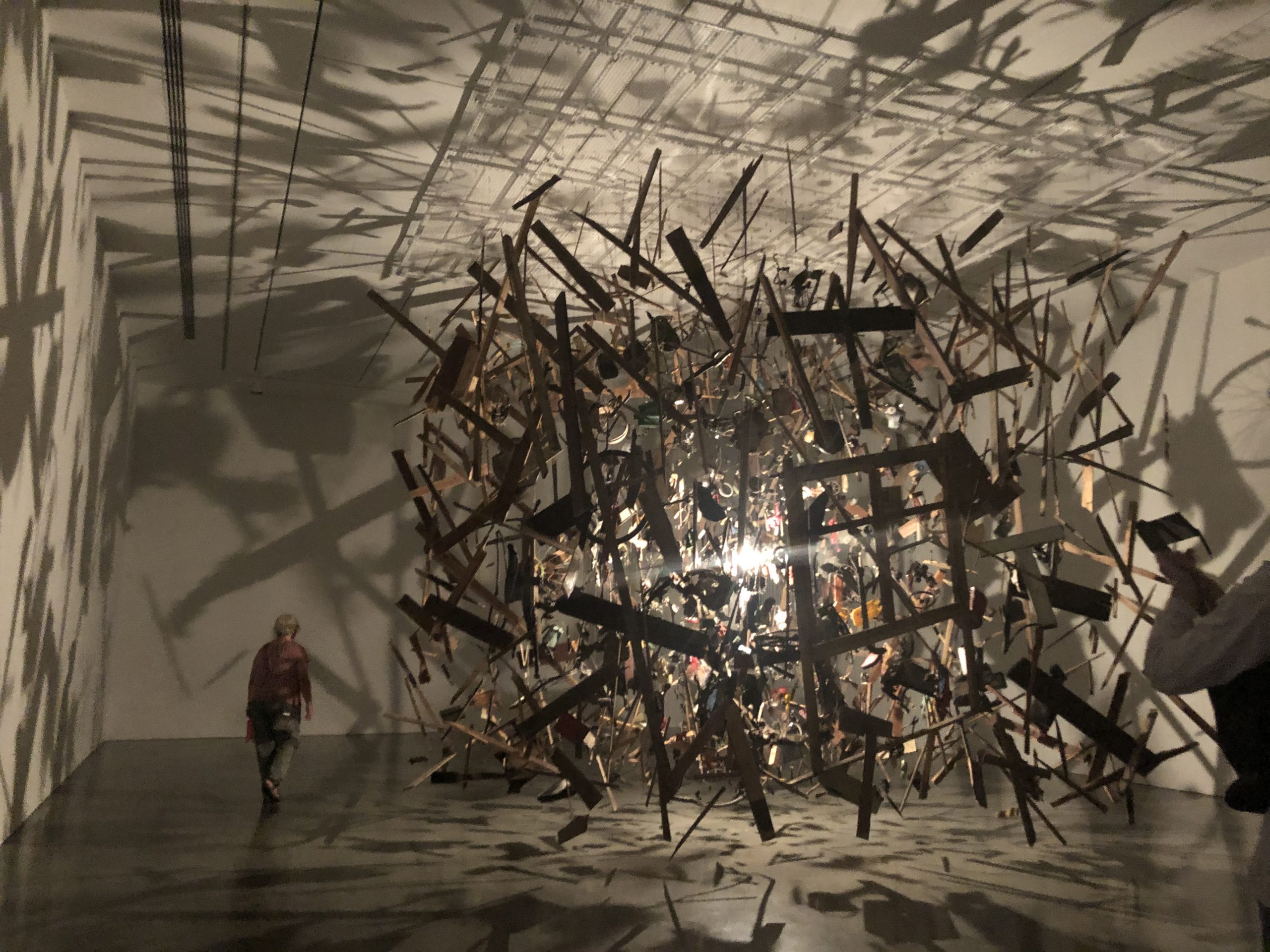Cornelia Parker’s genius finds its perfect expression in her large-scale installation War Room, 2015. In this work, the prominent UK artist has suspended the remnants of the 45 million Remembrance Day poppies created each year by the Poppy Factory in Richmond.
While the work is a potent reminder of war and lives lost to it, it’s also a quiet and meditative room like a chapel. In fact, when it was originally installed as part of a show at the Whitworth Gallery in Manchester, war veterans would enter the space and sing or take photographs to show their respect for the fallen soldiers.
I found Parker’s curvaceous creation mesmerising. For me, its pillowy curves evoked the visceral (a human haunch stripped of a layer of skin, a vast womb).
Parker says that in War Room, 2015 she was interested in showing the “missing” pieces – each poppy punched out by a machine and leaving a poppy-shaped hole in a sheet of red fabric. This brilliant concept is not only a sobering reminder of the cost of war but, with its calm and healing qualities and its nod to commemorative rituals, also speaks eloquently of peacetime and the antithesis of battle.
When I head in to view this installation there is just one young mother and her infant in the room with me. The woman pushes the pram to one side before studying the work from different perspectives and taking photographs. She has her back to the pram, always, which is angled away from her. When the baby gurgles, she says, “Sh, sh” quietly without turning towards it – as if she’s in a sacred space with circumscribed moves where tranquillity is the guiding imperative.

Photo: Marjorie Lewis-Jones
Parker says War Room 2015 is a pigeon pair with Cold Dark Matter: An Exploded View (1991). For this work she engaged the British Army to blow up a shed of household objects, and then hung the damaged pieces around a lightbulb. Shadows the suspended objects cast on the walls intensify its power as it speaks of war, soldiers and civilians primarily through their absence. What we see is the contents of a garden shed hanging in mid-air as the shed blows up. What we don’t see is the human who pushed the detonator switch, the military personnel who witnessed the explosion, or the person whose shed has been blasted apart.
Parker arranged the components of this work in a particular order to achieve the effect of a detonated building (although thankfully without the noise of the explosion). The suspended items are unmoored from their places and original uses. I noticed an old hair roller which, seen in this context, indicated much about how war and violence expose human frailty and can invade the most private and secretive aspects of a person’s life.
Thirty Pieces of Silver (1988–1989) is another large-scale and compelling work. It took Parker several years to collect enough teapots, jugs, platters, candlesticks and cutlery to achieve her vision. She laid a long trail of 1,000 silver-plated objects she’d collected on a road, and employed a man to drive a steamroller over them.
We learn from the BBC documentary Imagine that accompanies Parker’s Sydney exhibition that she overcame her childhood fears by placing coins on the railway tracks near her home and then racing back to safety where she could watch the trains beat them to thinness.
In Thirty Pieces of Silver Parker revisits her childhood game but goes one step further to reform these “useless” silver objects by making 30 pools in which 30 silver pieces are suspended. Traces of the pieces’ previous lives and uses are evident, but a new “history” is constructed for viewers to ponder.
The BBC documentary also follows Parker’s creation of a large-scale artwork for the roof of the Museum of Contemporary Art (MCA) in New York. With such a huge space to work with, Parker decides she wants to replicate the house in the Alfred Hitchcock movie Psycho. Her vision includes painting the house the traditional ochre-red of farm buildings that dot the countryside in the US and parts of Europe.
One of my favourite works in Parker’s exhibition at Sydney’s MCA is Verso, which consists of a series of photographs of the underside of button cards. Parker explains the beauty she saw in the cards she’d found displayed in a museum and longed to capture.
“When you looked at the cards the right way around,” she says, “the buttons were displayed in neat rows. But when you flipped them over you got this beautiful unconscious line drawing, made of the thread used to sew the button on the card.
“They were all so different and read as a kind of alternate, subconscious display, the flipside.”
The “flipside” photo of Parker’s I loved most looks like a Japanese woman in an angular kimono standing beside a pillar or a tree. I think the woman’s outfit may have been formed by some old sticky tape that fell off and left a yellowy stain on the card.
Verso is one of many delights in Parker’s Sydney exhibition, which features more than 40 artworks from across her career, including large-scale installations, embroideries, works on paper, video works, and a selection of small-scale sculptures and objects.
Don’t miss it.
_______________
The first major survey of Cornelia Parker’s work in the Southern Hemisphere is at the MCA in Sydney until February 16, 2020.





